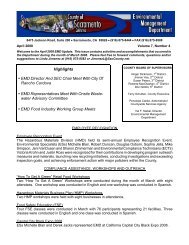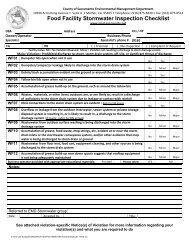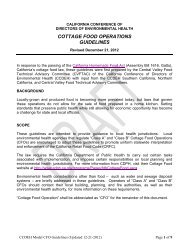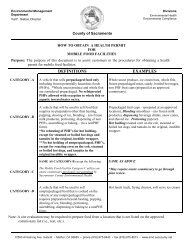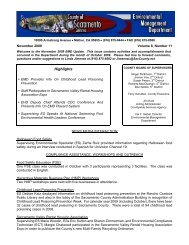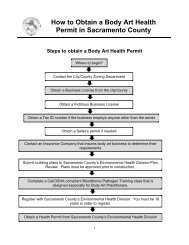California Water Well Standards, DWR Bulletin 74 ... - County of Glenn
California Water Well Standards, DWR Bulletin 74 ... - County of Glenn
California Water Well Standards, DWR Bulletin 74 ... - County of Glenn
- No tags were found...
Create successful ePaper yourself
Turn your PDF publications into a flip-book with our unique Google optimized e-Paper software.
1.Part II.Monitoring <strong>Well</strong> ConstructionSection 8. <strong>Well</strong> Location With Respect to Pollutants and Contaminants, and Structures.Monitoring wells are usually constructed to observe conditions at defined or required locations. Monitoringwell locations are usually selected on the basis <strong>of</strong> known or expected hydrologic, geologic, and water qualityconditions and the location <strong>of</strong> pollutant or contaminant sources. Monitoring wells frequently need to belocated close to or within areas <strong>of</strong> pollution or contamination.ASe~aration. Monitoring wells shall be located an adequate distance from known or potentialsources <strong>of</strong> pollution and contamination, including those listed in Section 8 <strong>of</strong> the <strong>Water</strong> <strong>Well</strong><strong>Standards</strong>, unless regulatory or legitimate data requirements necessitate they be located closer.B. Flooding and Drainage. Monitoring wells should be located in areas protected from flooding,if possible. Provisions for locating monitoring wells in areas <strong>of</strong> flooding and drainage arecontained in Section 8 <strong>of</strong> the <strong>Water</strong> <strong>Well</strong> <strong>Standards</strong>.c. AccessibilitY. All monitoring wells shall be located an adequate distance from buildings andother structures to allow access for well maintenance, modification, repair, and destruction,unless otherwise approved by the enforcing agency.D. Disposal <strong>of</strong> Wastes When Drillinl! in Contaminated or Polluted Areas. Drill cuttings andwastewater from monitoring wells or exploration holes in areas <strong>of</strong> known or suspectedcontamination or pollution shall be disposed <strong>of</strong> in accordance with all applicable federal, State,and local requirements. The enforcing agency should be contacted to determine requirementsfor the proper disposal <strong>of</strong> cuttings and wastewater.Section 9. Sealing the Upper Annular Space.The space between the monitoring well casing and the wall <strong>of</strong> the well boring, usually referred to as the"annular space," shall be effectively sealed to prevent it from being a preferential pathway for the movement<strong>of</strong> poor quality water, pollutants, and contaminants. Since monitoring wells are <strong>of</strong>ten constructed to obtainwater from discrete intervals, a secondary purpose <strong>of</strong> the annular seal can be to isolate the well intake sectionor screen to one water-bearing unit. The annular seal can also serve to protect the structural integrity <strong>of</strong> thewell casing and to protect the casing from chemical attack and corrosion. Because monitoring wells are <strong>of</strong>tenlocated close to, or within areas affected by pollutants and contaminants, an effective annular seal is <strong>of</strong>tencritical for the protection <strong>of</strong> ground water quality.General discussion <strong>of</strong> sealing methods and requirements for monitoring wells is contained in Section 9,Section 13, and Appendix B, <strong>of</strong> the <strong>Water</strong> <strong>Well</strong> <strong>Standards</strong>. Special requirements for monitoring wells includethe following:AMinimum DeQth <strong>of</strong> Annular Seal.<strong>Water</strong> Qualitv monitorinl! wells and monitoring wells constructed in areas <strong>of</strong> known orsusp;ected p;ollution or contamination. The annular space shall be sealed from the top<strong>of</strong> the filter pack or monitoring zone to ground surface, unless otherwise approved bythe enforcing agency. The top <strong>of</strong> the filter pack or monitoring zone shall not extendinto another water-bearing unit above the single water-bearing unit being monitoredunless otherwise approved by the enforcing agency. The filter pack or monitoring zoneshall not extend into any confining layers that overlie or underlie the unit to be moni--41-



